The Effect of Refined Separation on the Properties of Reclaimed Asphalt Pavement Materials
Abstract
:1. Introduction
2. Refined Separation Principle
3. Materials and Methods
3.1. RAP Materials
3.2. Test Methods
4. The Effect Evaluation of Refined Separation on RAP
4.1. Gradation Variability of RAP
4.2. Agglomeration Degree of RAP
4.3. Aggregate Properties of RAP
4.4. Asphalt Content Variability of RAP
4.5. Asphalt Properties of RAP
5. The Calculation Method of Maximum Addition Proportion of RAP for Recycled Asphalt Mixture
5.1. Maximum Addition Proportion of RAP under the Control of Gradation Variability
5.2. Maximum Addition Proportion of RAP under the Control of Asphalt Content Variability
6. Conclusions
- (1)
- The refined separation process can effectively reduce the variability of RAP and enhance the property stability of RAP.
- (2)
- The RAP false particles decreased significantly after refined separation and were closer to the natural mineral material. RAP agglomeration degree decreases with increasing frequency parameters of refined separation. Comparing with the Ic values of A1, A2, and A3, those of E1, E2, and E3 decreased by 6.40%, 4.30%, and 4.30%, respectively.
- (3)
- The asphalt content of the coarse RAP materials after refined separation decreases gradually with increasing frequency parameter. For 0–5 mm grain size RAP, the asphalt content of A3 changed less compared to that of the refined separated RAP.
- (4)
- Based on the quality control requirements of hot mix asphalt mixtures, the maximum blending percentage of RAP coarse material was calculated using the gradation variability control method and asphalt content variability control method, respectively. The refined separation process can significantly increase the maximum addition ratio of RAP material.
- (5)
- Through refined separation, it is conducive to improving the addition proportion of RAP in the recycled asphalt mixture, ensuring the quality of the recycled asphalt mixture, and further maximizing the potential value of RAP. This enhances the environmental benefits of recycling RAP and economic benefits.
Author Contributions
Funding
Data Availability Statement
Conflicts of Interest
References
- Miao, Y.; Wang, S.; Guo, L.; Zheng, X.; Huang, Y.; Wang, L. Effect of temperature on deformation properties of unbound granular materials containing fine RAP. Constr. Build. Mater. 2018, 169, 443–451. [Google Scholar] [CrossRef]
- He, Y.; Wang, Q.; Zhang, J.; Li, Y.; He, H.; Huang, G. Foamed crumb rubber asphalt binder: Preparation, rheological properties and adhesion characteristics. J. Clean. Prod. 2023, 396, 136516. [Google Scholar] [CrossRef]
- Qu, L.; Wang, Y.; Wang, L.; Li, X.; Xiao, Y. Experimental evaluation of fatigue performance of recycled asphalt mixture using refined separation recycled aggregates. Constr. Build. Mater. 2024, 411, 134786. [Google Scholar] [CrossRef]
- Gao, X.; He, W.; Zhou, X. Dynamic Mechanical Properties of Hot-in-Place Recycled Asphalt Mixtures. Sci. Technol. Eng. 2022, 22, 15742–15748. [Google Scholar]
- Wang, J.; Qin, Y.; Huang, S.; Bo, Z.; Guo, S. Variability of Reclaimed Asphalt Pavement. J. Beijing Univ. Technol. 2018, 44, 244–250. [Google Scholar]
- Gonçalves Luz, P.M.S.; Silva, I.M.; de Medeiros Melo Neto, O.; Dias, T.L.; de Figueiredo Lopes Lucena, L.C.; Sampaio, R.M.B. Analysis of the Degree of Blending (DoB) of recycled asphalt mixtures with variation in mixing temperature, type, and RAP content. Constr. Build. Mater. 2024, 431, 136577. [Google Scholar] [CrossRef]
- Xu, J.-Z.; Hao, P.-W.; Guo, X.-G.; Li, H.-X.; Zhang, B.-J.; Le, C. Review of Mix Design Method of Hot In-plant Recycled Asphalt Mixture. China J. Highw. Transp. 2021, 34, 72–88. [Google Scholar]
- Zou, F.; Ye, F.; Song, Q. Effect of RAP percentage on pavement performance of recycled asphalt mixtures. J. Jilin Univ. (Sci. Ed.) 2020, 50, 1403–1410. [Google Scholar]
- Zou, X.; Li, N.; Wu, W.; Hu, Y.; Zhang, Y.; Tang, W. Study on Effect of Fine Separation on RAP Material Properties. J. Dalian Jiaotong Univ. 2023, 44, 71–76. [Google Scholar]
- Ai, X.; Cao, J.; Feng, D.; Gao, L.; Hu, W.; Yi, J. Performance evaluation of recycled asphalt mixtures with various percentages of RAP from the rotary separation process. Constr. Build. Mater. 2022, 321, 126406. [Google Scholar] [CrossRef]
- Yu, X.; Tang, W.; Li, N.; Jiang, M.; Huang, J.; Wang, D. Refined separation: A new separation method for RAP materials and its effect on aggregate properties. Constr. Build. Mater. 2022, 358, 129452. [Google Scholar] [CrossRef]
- Akatsu, K.; Kanou, Y.; Aiba, S. Separation Recycling Technology for Restoring Reclaimed Asphalt Pavement. J. JSCE 2018, 6, 110–117. [Google Scholar] [CrossRef]
- Feng, D.; Cao, J.; Gao, L.; Yi, J. Recent developments in asphalt-aggregate separation technology for reclaimed asphalt pavement. J. Road Eng. 2022, 2, 332–347. [Google Scholar] [CrossRef]
- Wang, T.; Zhang, C.; Zhao, R.; Zhu, C.; Yang, C.; Liu, C. Solvent Extraction of Bitumen from Oil Sands. Energy Fuels 2014, 28, 2297–2304. [Google Scholar] [CrossRef]
- Xue, J.; Yu, Y.; Bai, Y.; Wang, L.; Wu, Y. Marine Oil-Degrading Microorganisms and Biodegradation Process of Petroleum Hydrocarbon in Marine Environments: A Review. Curr. Microbiol. 2015, 71, 220–228. [Google Scholar] [CrossRef]
- Zhang, Y.; Chen, H.; Wang, K.; Huang, G.; Shen, Z.; Sun, L. Effect of recycled aggregate gradation on the degree of blending and performance of recycled hot-mix asphalt (HMA). J. Clean. Prod. 2023, 398, 136550. [Google Scholar] [CrossRef]
- Katla, B.; Raju, S.; Waim, A.R.; Danam, V.A. Utilization of Higher Percentages of RAP for Improved Mixture Performance by Adopting the Process of Fractionation. Int. J. Pavement Res. Technol. 2022, 15, 349–366. [Google Scholar] [CrossRef]
- Yang, J.; Zhang, W.; Gao, J.; Yao, Y.; Sun, C. Optimizing RAP sieving efficiency of linear vibrating sieve using DEM simulation. Constr. Build. Mater. 2022, 333, 127442. [Google Scholar] [CrossRef]
- Yang, J.; Tao, W.; Gao, J.; Yu, D.; Zhou, J.; He, L.; Yao, Y. Measurement of particle agglomeration and aggregate breakdown of reclaimed asphalt pavement. Constr. Build. Mater. 2021, 296, 123681. [Google Scholar] [CrossRef]
- Bressi, S.; Dumont, A.G.; Partl, M.N. A new laboratory methodology for optimization of mixture design of asphalt concrete containing reclaimed asphalt pavement material. Mater. Struct. 2016, 12, 4975–4990. [Google Scholar] [CrossRef]
- Xiao, F.; Su, N.; Yao, S.; Amirkhanian, S.; Wang, J. Performance grades, environmental and economic investigations of reclaimed asphalt pavement materials. J. Clean. Prod. 2019, 211, 1299–1312. [Google Scholar] [CrossRef]
- Montañez, J.; Caro, S.; Carrizosa, D.; Calvo, A.; Sánchez, X. Variability of the mechanical properties of Reclaimed Asphalt Pavement (RAP) obtained from different sources. Constr. Build. Mater. 2020, 230, 116968. [Google Scholar] [CrossRef]
- Liu, Y.; Qiu, Q.; Ji, W.; Pang, L.; Li, N.; Tang, W.; Zhan, H. Effect of RAP Classification on Road Performance Variability of Hot Recycled Asphalt Mixture. Highw. Eng. 2021, 46, 68–72. [Google Scholar]
- Guo, P.; Wei, W.; Tang, B.; Yang, F. Evaluation of High-temperature Performance of Asphalt Mixture based on Angularity of Recycled Coarse Aggregate. Highway 2017, 69, 220–225. [Google Scholar]
- Orešković, M.; Pires, G.M.; Bressi, S.; Vasconcelos, K.; Presti, D.L. Quantitative assessment of the parameters linked to the blending between reclaimed asphalt binder and recycling agent: A literature review. Constr. Build. Mater. 2020, 234, 117323. [Google Scholar] [CrossRef]
- Liu, J.; Liu, Q.; Wang, S.; Zhang, X.; Xiao, C.; Yu, B. Molecular dynamics evaluation of activation mechanism of rejuvenator in reclaimed asphalt pavement (RAP) binder. Constr. Build. Mater. 2021, 298, 123898. [Google Scholar] [CrossRef]
- Meng, Y.; Liu, L.; Huang, W.; Li, M. Effect of increasing preheating temperature on the activation and aging of asphalt binder in reclaimed asphalt pavement (RAP). J. Clean. Prod. 2023, 402, 136780. [Google Scholar] [CrossRef]
- Xing, C.; Li, M.; Liu, L.; Lu, R.; Liu, N.; Wu, W.; Yuan, D. A comprehensive review on the blending condition between virgin and RAP asphalt binders in hot recycled asphalt mixtures: Mechanisms, evaluation methods, and influencing factors. J. Clean. Prod. 2023, 398, 136515. [Google Scholar] [CrossRef]
- Pires, G.M.; Presti, D.L.; Airey, G.D. A practical approach to estimate the degree of binder activity of reclaimed asphalt materials. Road Mater. Pavement Des. 2021, 22, 1093–1116. [Google Scholar] [CrossRef]
- Meng, Y.; Liu, L. Impact of Preheating Temperatures and RAP Characteristics on the Activation of RAP Binder. Appl. Sci. 2020, 10, 8378. [Google Scholar] [CrossRef]
- Gao, J.; Yang, J.; Yu, D.; Jiang, Y.; Ruan, K.; Tao, W.; Sun, C.; Luo, L. Reducing the variability of multi-source reclaimed asphalt pavement materials: A practice in China. Constr. Build. Mater. 2021, 278, 122389. [Google Scholar] [CrossRef]
- Zaumanis, M.; Oga, J.; Haritonovs, V. How to reduce reclaimed asphalt variability: A full-scale study. Constr. Build. Mater. 2018, 188, 546–554. [Google Scholar] [CrossRef]
- Xue, Y.; Liu, C.; Qu, J.; Lv, S.; Ju, Z.; Ding, S.; An, H.; Ren, K. Research on pavement performance of recycled asphalt mixture based on separation technology of asphalt and aggregate in RAP. Constr. Build. Mater. 2023, 393, 132103. [Google Scholar] [CrossRef]
- Pan, Y.; Li, J.; Yang, T.; Liu, G.; Zhou, J.; Guo, P.; Zhao, Y. Optimization of gradation design of recycled asphalt mixtures based on fractal and Mohr-Coulomb theories. Constr. Build. Mater. 2020, 248, 118649. [Google Scholar] [CrossRef]
- Yao, Y.; Yang, J.; Gao, J.; Zheng, M.; Xu, J.; Zhang, W.; Song, L. Strategy for improving the effect of hot in-place recycling of asphalt pavement. Constr. Build. Mater. 2023, 366, 130054. [Google Scholar] [CrossRef]
- Zou, G.; Zha, Z.; Dong, S.; An, Q. Effect of plant-mixed recycled RAP pretreatment process on separation efficiency. Constr. Mach. Equip. 2022, 53, 56–62. [Google Scholar]
- Qiu, J.; Huurman, M.; de Bruin, B.; Demmink, E.; Frunt, M. Towards 90% warm re-use of porous asphalt using foaming technology. J. Clean. Prod. 2018, 190, 251–260. [Google Scholar] [CrossRef]
- Peng, W. Research on recycling technology of waste asphalt mixture based on dry oil-aggregate separation. Eng. Technol. Res. 2021, 6, 9–11. [Google Scholar]
- JTG E42-2005; Test Methods of Aggregate for Highway Engineering. Ministry-of-Transport-of-the-People’s-Republic-of-China, China Communications Press: Beijing, China, 2005.
- JTG E20-2011; Standards Test Methods of Bitumen and Bituminous Mixtures for Highway Engineering. Ministry-of-Transport-of-the-People’s-Republic-of-China, China Communications Press: Beijing, China, 2011.
- JTG F40-2004; Technical Specifications for Construction of Highway Asphalt Pavements. Ministry-of-Transport-of-the-People’s-Republic-of-China, China Communications Press: Beijing, China, 2004.
- Huang, X.; Zhao, Y. Theory and Practice of Asphalt Pavement Recycling; Science and Technology of China Press: Beijing, China, 2014. [Google Scholar]
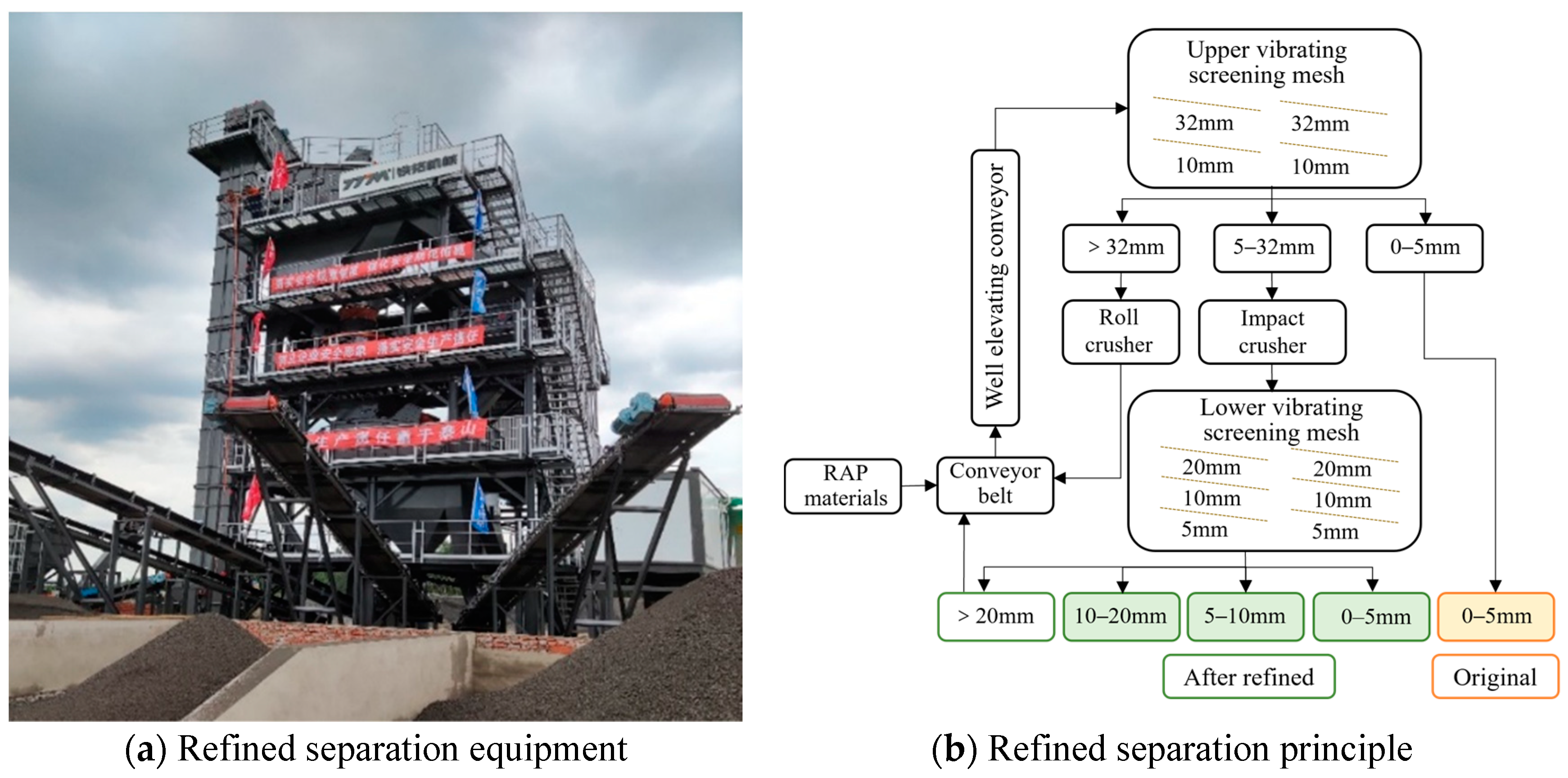

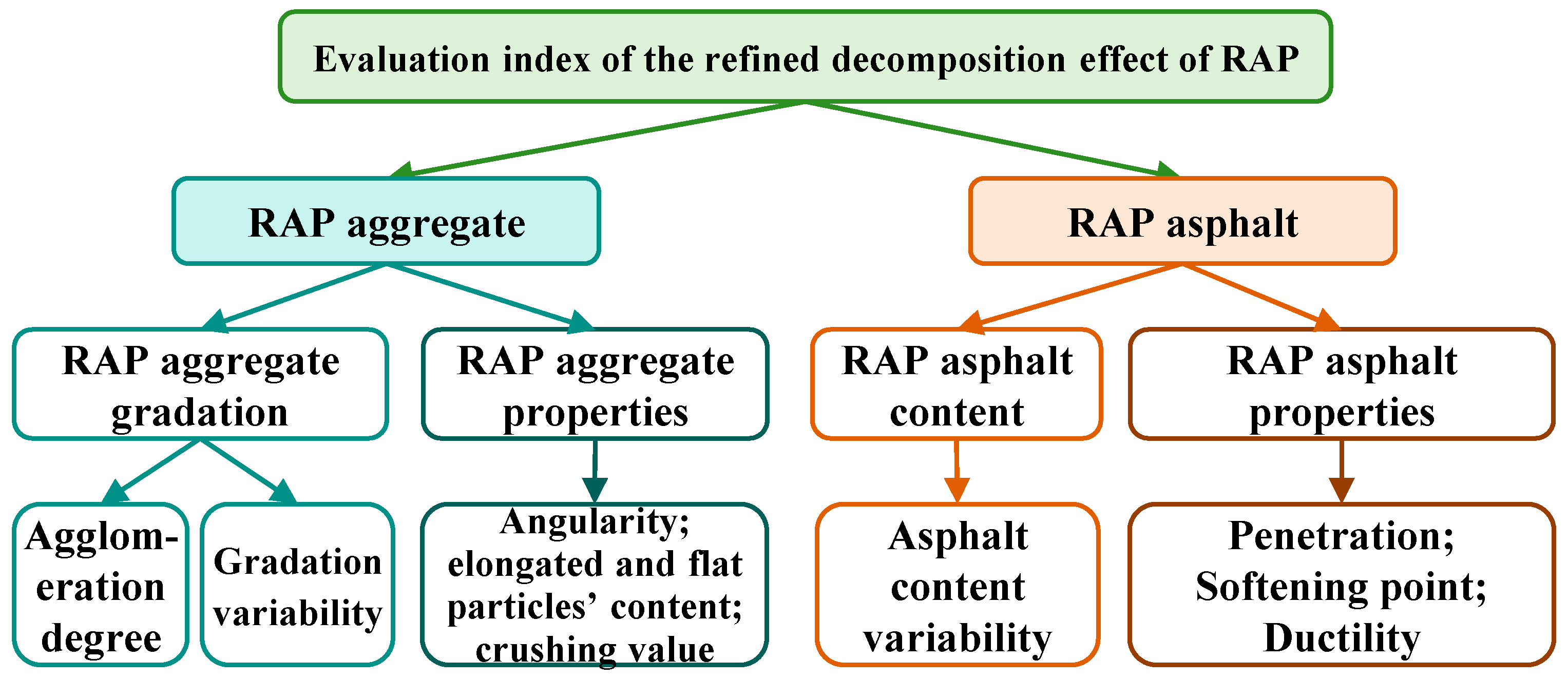
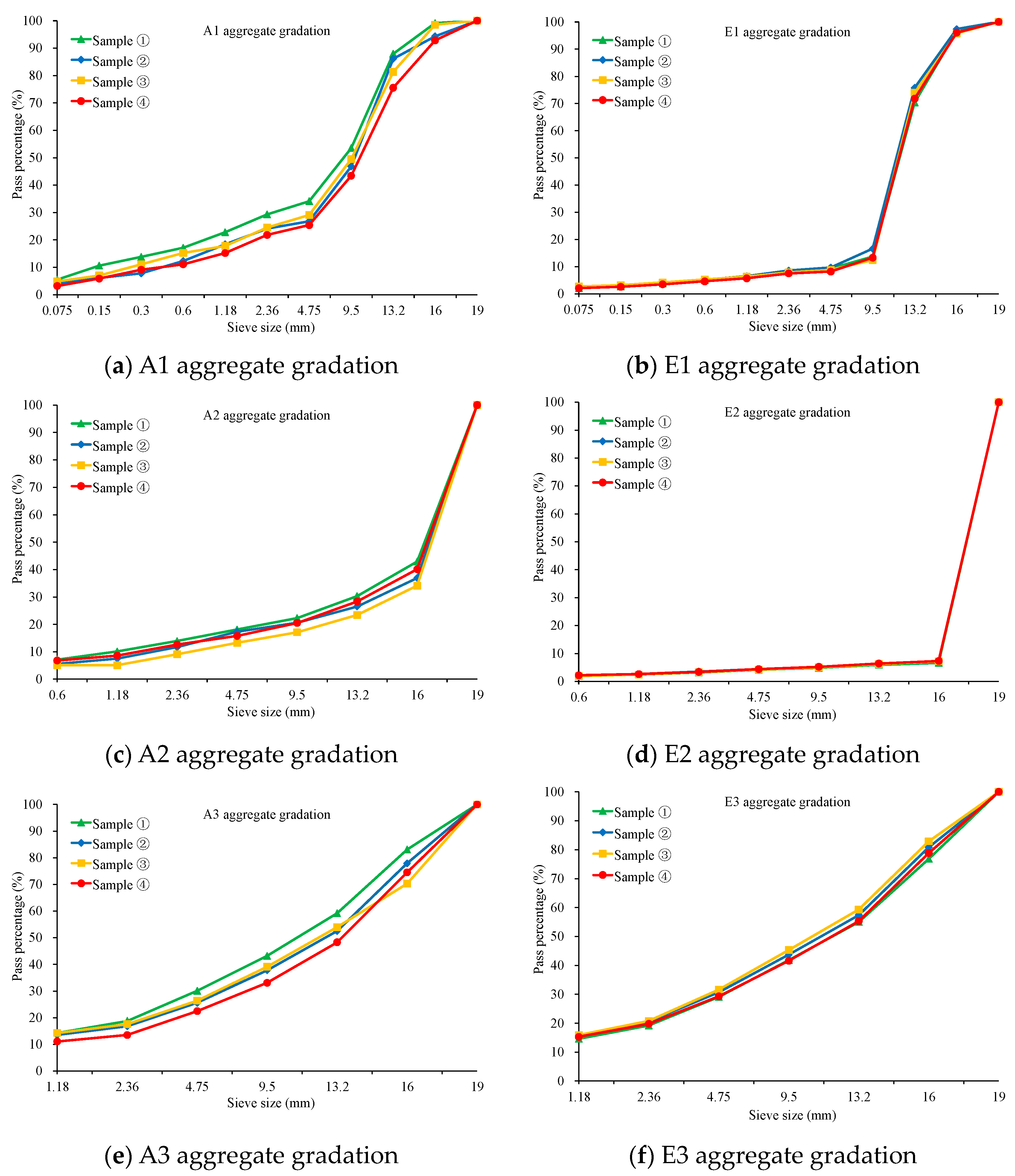
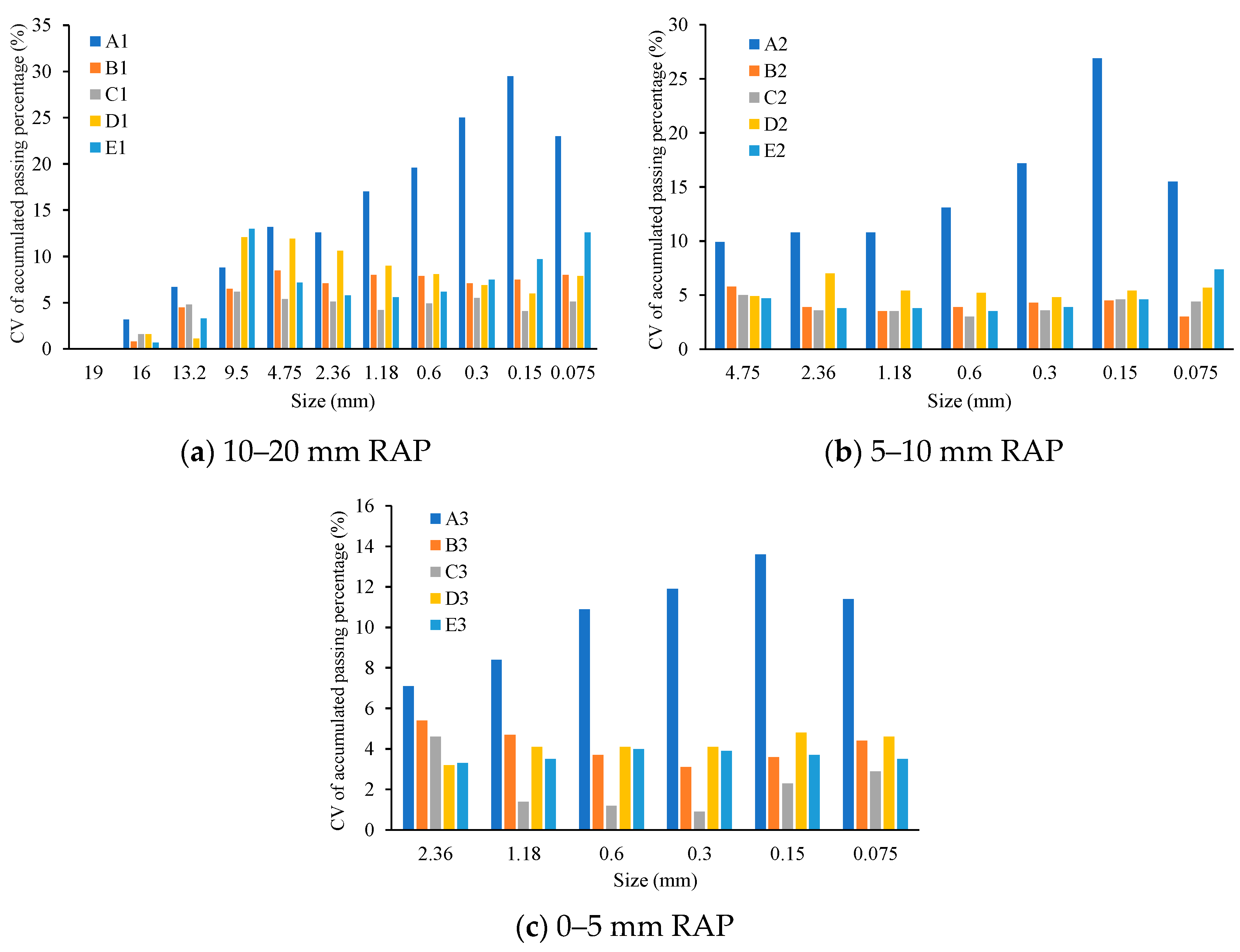

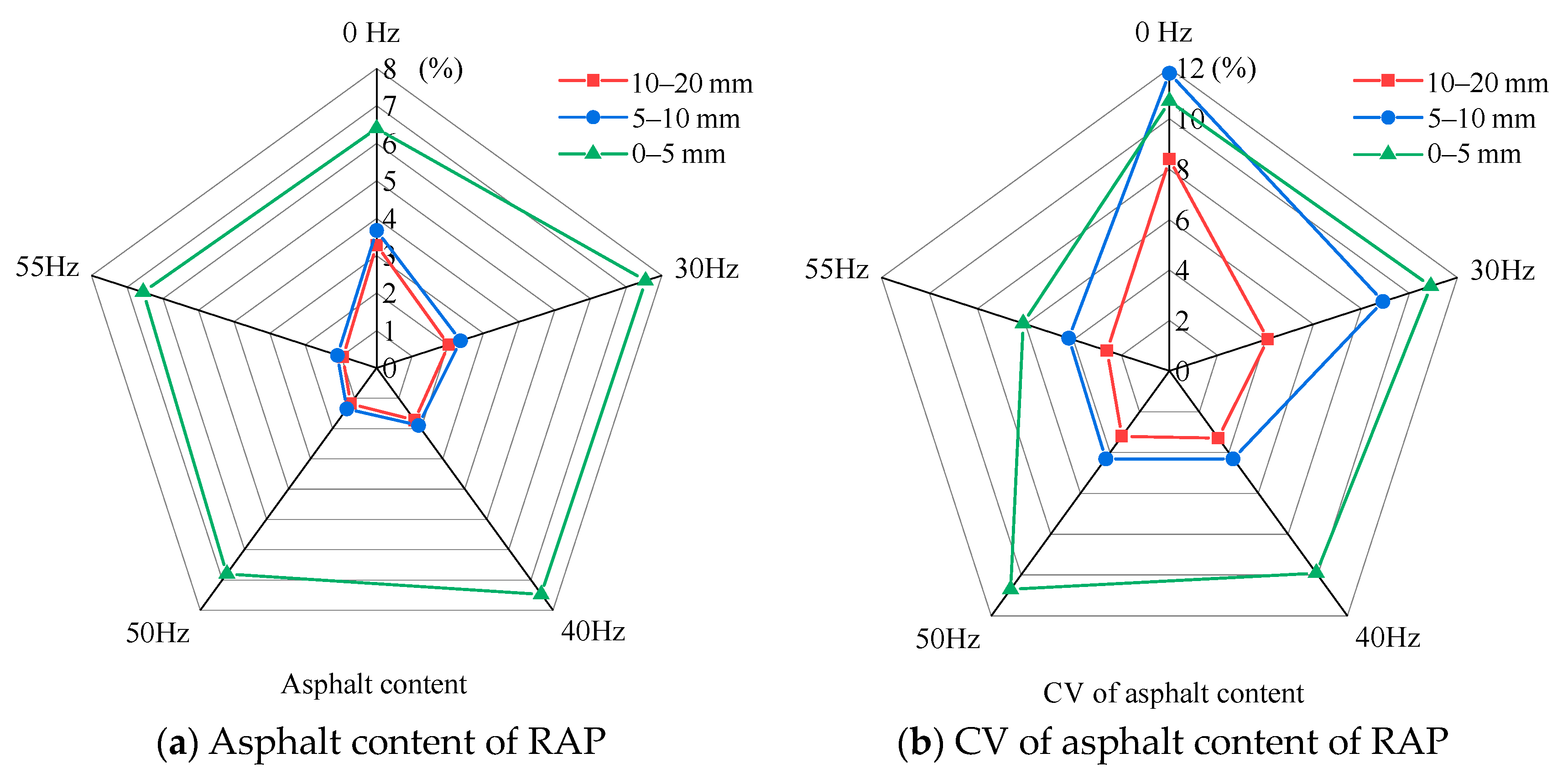


| Size (mm) | Refined Separation Frequency (Hz) | ||||
|---|---|---|---|---|---|
| 0 | 30 | 40 | 50 | 55 | |
| 10–20 | A1 | B1 | C1 | D1 | E1 |
| 5–10 | A2 | B2 | C2 | D2 | E2 |
| 0–5 | A3 | B3 | C3 | D3 | E3 |
| Index | Size (mm) | Refined Separation Frequency (Hz) | ||||
|---|---|---|---|---|---|---|
| 0 | 30 | 40 | 50 | 55 | ||
| Angularity | 5–10 | 17.90 | 17.53 | 17.29 | 17.18 | 17.16 |
| 10–20 | 17.63 | 17.25 | 17.19 | 16.89 | 16.82 | |
| Elongated and flat particle content (%) | 5–10 | 6.39 | 5.29 | 4.79 | 3.99 | 3.19 |
| 10–20 | 6.68 | 5.39 | 4.80 | 4.20 | 3.20 | |
| Crushed value (%) | 10–20 | 6.19 | 5.60 | 5.30 | 5.10 | 5.00 |
| Sieve Size (mm) | Number of Samples | Quality Requirements |
|---|---|---|
| Highway | ||
| 0.075 mm | RAP material sample number n: n ≥ 4 | XV0.075 ≤ 1% |
| ≤2.36 mm | XV≤2.36 ≤ 3% | |
| ≥4.75 mm | XV≥4.75 ≤ 4% |
| Sieve Size (mm) | Quality Requirements | |||
|---|---|---|---|---|
| A1 | A2 | E1 | E2 | |
| 19 | 0.0%X ≤ 4% | 0.0%X ≤ 4% | - | - |
| 16 | 4.9%X ≤ 4% | 1.1%X ≤ 4% | - | - |
| 13.2 | 8.8%X ≤ 4% | 3.8%X ≤ 4% | - | - |
| 9.5 | 6.8%X ≤ 4% | 2.9%X ≤ 4% | 0.0%X ≤ 4% | 0.0%X ≤ 4% |
| 4.75 | 6.1%X ≤ 4% | 1.0%X ≤ 4% | 6.1%X ≤ 4% | 0.5%X ≤ 4% |
| 2.36 | 5.0%X ≤ 3% | 0.7%X ≤ 3% | 4.7%X ≤ 3% | 0.4%X ≤ 3% |
| 1.18 | 5.0%X ≤ 3% | 0.6%X ≤ 3% | 3.5%X ≤ 3% | 0.3%X ≤ 3% |
| 0.6 | 4.3%X ≤ 3% | 0.5%X ≤ 3% | 3.4%X ≤ 3% | 0.2%X ≤ 3% |
| 0.3 | 4.2%X ≤ 3% | 0.5%X ≤ 3% | 3.2%X ≤ 3% | 0.2%X ≤ 3% |
| 0.15 | 3.5%X ≤ 3% | 0.4%X ≤ 3% | 3.4%X ≤ 3% | 0.2%X ≤ 3% |
| 0.075 | 1.6%X ≤ 1% | 0.5%X ≤ 1% | 1.5%X ≤ 1% | 0.2%X ≤ 1% |
Disclaimer/Publisher’s Note: The statements, opinions and data contained in all publications are solely those of the individual author(s) and contributor(s) and not of MDPI and/or the editor(s). MDPI and/or the editor(s) disclaim responsibility for any injury to people or property resulting from any ideas, methods, instructions or products referred to in the content. |
© 2024 by the authors. Licensee MDPI, Basel, Switzerland. This article is an open access article distributed under the terms and conditions of the Creative Commons Attribution (CC BY) license (https://creativecommons.org/licenses/by/4.0/).
Share and Cite
Wang, Y.; Dou, G.; Wang, S.; Wang, J. The Effect of Refined Separation on the Properties of Reclaimed Asphalt Pavement Materials. Buildings 2024, 14, 1608. https://doi.org/10.3390/buildings14061608
Wang Y, Dou G, Wang S, Wang J. The Effect of Refined Separation on the Properties of Reclaimed Asphalt Pavement Materials. Buildings. 2024; 14(6):1608. https://doi.org/10.3390/buildings14061608
Chicago/Turabian StyleWang, Yuanfu, Guangwu Dou, Sudi Wang, and Jie Wang. 2024. "The Effect of Refined Separation on the Properties of Reclaimed Asphalt Pavement Materials" Buildings 14, no. 6: 1608. https://doi.org/10.3390/buildings14061608





